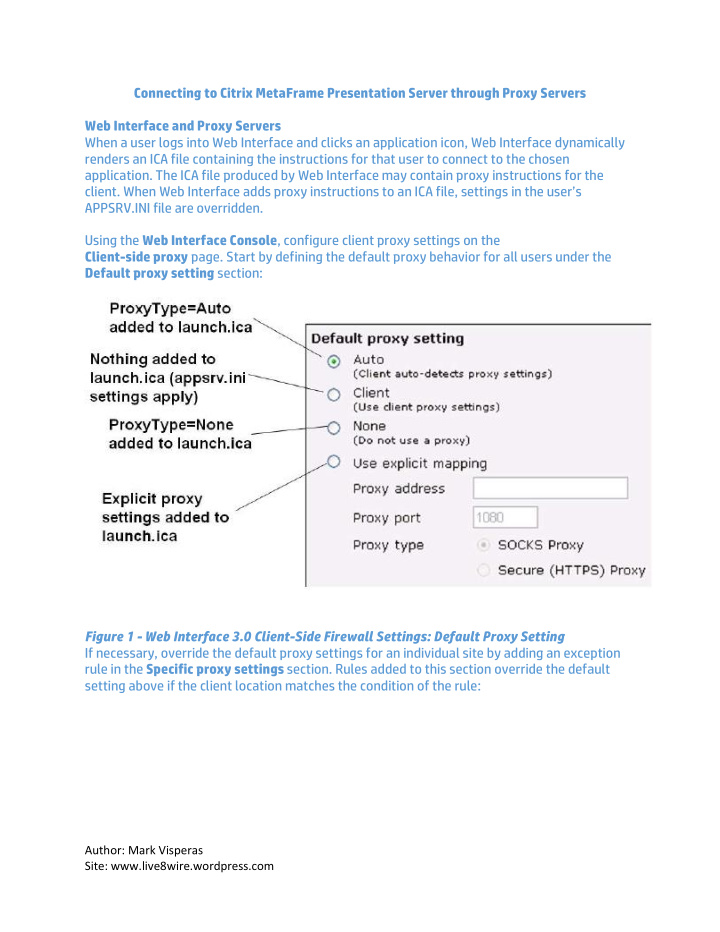



Connecting to Citrix MetaFrame Presentation Server through Proxy Servers Web Interface and Proxy Servers When a user logs into Web Interface and clicks an application icon, Web Interface dynamically renders an ICA file containing the instructions for that user to connect to the chosen application. The ICA file produced by Web Interface may contain proxy instructions for the client. When Web Interface adds proxy instructions to an ICA file, settings in the user’s APPSRV.INI file are overridden. Using the Web Interface Console , configure client proxy settings on the Client-side proxy page. Start by defining the default proxy behavior for all users under the Default proxy setting section: Figure 1 - Web Interface 3.0 Client-Side Firewall Settings: Default Proxy Setting If necessary, override the default proxy settings for an individual site by adding an exception rule in the Specific proxy settings section. Rules added to this section override the default setting above if the client location matches the condition of the rule: Author: Mark Visperas Site: www.live8wire.wordpress.com
Figure 2: Client Network Address May Be a Proxy Address Editing Client-Side Proxy Settings If you are using a proxy server at the client-side of the Web Interface installation, you can configure whether or not clients must communicate with the server through the proxy server. You use the Edit client-side proxy task to do this. A proxy server positioned at the client-side of a Web Interface installation provides security benefits that include: • Information hiding, where system names inside the firewall are not made known to systems outside the firewall through DNS (Domain Name System) • Channeling different TCP connections through one connection using the Access Management Console, you can set default proxy rules for clients. However, you can also configure exceptions to this behavior for individual clients. To configure exceptions, you associate the proxy server's external IP address with a Web Interface proxy setting. You can also specify that proxy behavior is controlled by the client. For example, to use the Secure Proxy feature in Presentation Server, configure the Web Interface to use the proxy settings specified on the client and configure the client for Secure Proxy. For more information about using clients to control proxy behavior, see the releva nt Administrator’s Guide. Author: Mark Visperas Site: www.live8wire.wordpress.com
To configure default proxy settings 1. Click the Edit client-side proxy task. 2. Click Add to create a new mapping or Edit to edit an existing mapping. 3. Enter the external address of the proxy in the IP Address box. 4. Enter the subnet mask in the Subnet Mask box. 5. In the Proxy list, select one of the following: • User's browser setting. The client auto -detects the Web proxy based on the client’s browser configuration. • Web proxy auto detect. The client auto -detects the Web proxy using the Web Proxy Auto Discovery (WPAD) protocol. • Client defined. The settings configured for the client by the user. • None. No proxy is used. • SOCKS. If this option is selected, you must enter the address of the proxy server in the Proxy Address box and the port number in the Proxy Port box. The proxy address can be an IP address or a DNS name. • Secure (HTTPS). If this option is selected, you must enter the address of the proxy server in the Proxy Address box and the port number in the Proxy Port box. The proxy address can be an IP address or a DNS name. 6. Click OK. The mapping is added to the Mapping list. 7. You can control the order in which multiple mappings are applied. Select a mapping and click Move Up or Move Down to place the mappings in order of priority. To remove a mapping, select the mapping and click Remove. Author: Mark Visperas Site: www.live8wire.wordpress.com
Recommend
More recommend